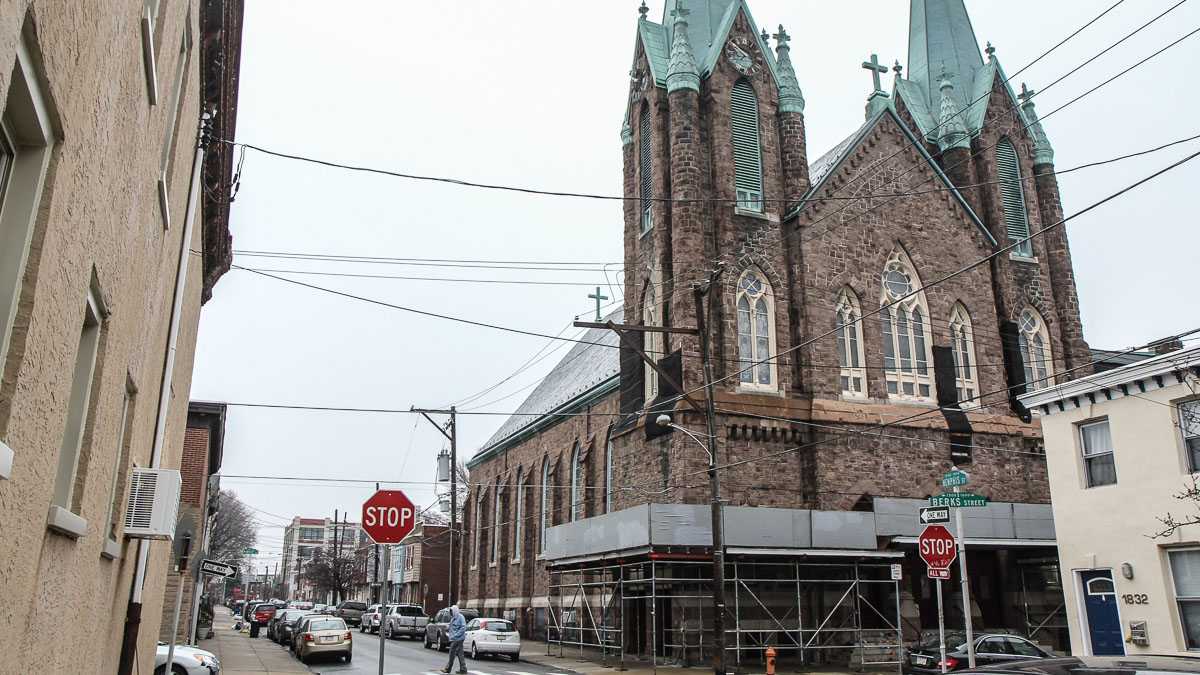Committee hesitant to recommend historic designation for St. Laurentius’ interior

On Wednesday the Historical Commission’s Designation Committee ended up on the receiving end of a lecture about the wrongs suffered by Polish people in the modern era, in a nearly two-hour opening case for designating the interior of Fishtown’s closed St. Laurentius Church as historic.
The committee too heard a case for declaring the interior of St. Laurentius, the oldest Polish church in Philadelphia. It is currently sealed to the public after being deconsecrated by the Archdiocese in 2014.
The building exterior won a place on the local historic register last year. Now developer Leo Voloshin has an agreement to reuse the church as an apartment building. Experts from the Preservation Alliance for Greater Philadelphia and the City Planning Commission agree that this is probably the best way to save the church, but a vocal group of neighbors are opposed to what they argue is the privatization of a community landmark.
The meeting opened with John Wisniewski, whose name graces the nomination of the interior, giving an impassioned lecture on the forces that propelled Poles to immigrate to the United States.
“I think it’s important, without giving you a history lesson, that you understand the ideology of Polish immigrants and why they constructed the churches the way they did,” said Wisniewski.
His story began with the doom of the Polish–Lithuanian Commonwealth, its eventual partition between the empires of Prussia, Austria, and Russia, and a tale of woe that stretched through the World Wars, Nazi rule, and Communism as an explanation for why Polish-Americans cared so deeply for their churches. They built to resemble those that were lost in Eastern Europe.
The zoning lawyer Michael Phillips, who represented the Archdiocese and the Holy Name of Jesus Parish, into which St. Laurentius was merged, did not try to counter the importance of St. Laurentius to Polish-American traditions or the neighborhood. Instead he fought on more technical grounds, saying that many of the objects within the church that are described in the nomination have been removed. Phillips also asserted that because the building is deconsecrated, the remaining artifacts are the property of the Church.
Phillips also argued that the building could not be considered a public building. For the city to designate an interior as historic it must be a public space or an area into which the public would commonly be invited. A hard hat and an insurance waiver are needed to enter St. Laurentius these days, according to Phillips, so it can’t really be considered public anymore.
The only two other interior designations in Philadelphia are of spaces that were public when they won protection, City Council’s chambers, and parts of the old Family Court building. The attempted interior nomination of the Blue Horizon Theater was not supported for designation because committee members felt it was not a sufficiently public enough space.
“The Blue Horizon came before committee on both exterior and interior nominations,” said Phillips. “But the exterior was designated, while the interior was not even recommended for designation.”
But Phillips and Voloshin, the developer, faced a steady stream of opposition. The testimony split between those who spoke about the site’s importance to the neighborhood and those who tried to place it in the grander story of Polish-American heritage, including Poland’s Honorary Consul in Philadelphia who spoke in favor of the nomination.
After over an hour of back-and-forth, preservation activist Oscar Beisert stood up to testify. Instead of testifying in support of the nomination, he argued that supporters of the building shouldn’t allow the perfect to be the enemy of the good. (In turns out that Beisert wrote the nomination for the exterior and the interior of St. Laurentius, but he asked his name be removed from the later because he doesn’t support narrowing its use to only religious or community purposes.)
“I sympathize with the Faithful Laurentians, believe me, I would prefer the whole city at 1945 without changing a thing—except maybe central air,” said Beisert. “My fear is that as much as we would love to see the interior preserved, designating the interior may prevent the preservation of the entire building. There is a developer here willing to turn this into apartments. Is that a perfect solution? No. But he’s the only person here with the funds to do it and to protect the building now.”
As the Designation Committee began to actively consider the case, it became clear that they didn’t put much store in Phillips arguments for outright rejection of the nomination. Committee member Jeffrey Cohen, an architectural historian, described it as “churlish” to say that the public couldn’t enter the building so therefore it couldn’t be nominated.
That prompted Phillips to wheel out an argument based on the First Amendment, saying that such a nomination could represent an intrusion by the state into the grounds of a religious institution. (The building still belongs to the Catholic Church until Voloshin can secure the necessary permits; the artifacts within are also property of the Archdiocese).
While Cohen and his colleagues professed themselves very sympathetic to the parishioners’ cause, that point did make them hesitate.
“My inclination is to say this is a historic place with historic value, at the same time I worry to what degree we should assert municipal authority over religious interiors,” said Cohen. “Especially for parts that aren’t moveable, that’s a conversation that really hasn’t happened yet. There is a first amendment concern for these religious objects.”
This line of argumentation brought the hearing to a close on a heated note. Wisniewski and other supporters of the interior designation denouncing the “nauseating things” that have occurred in the last three years. An argument raged over what, exactly, remained in the church and came to no firm conclusion.
The committee ended by voting to recommend a continuance of the nomination’s consideration. It suggested supporters of the interior designation could return with a nomination of the objects in the building instead of the entirety of the interior.
Throughout the case, Cohen kept wishing that the two sides could come to some sort of accord. Perhaps where the parishioners could get some of the artifacts, while Voloshin preserved the hard to move frescos. But the conflict over the adaptive reuse of St Laurentius has been ongoing for months and the battle is very contentious. Cohen’s plea for peace and common ground may not find many receptive ears.
“I do like that they want us to work with the developer,” said Venise Whitaker of the Faithful Laurentians. “I have personally tried to reach out to workwith them. They said absolutely not.”
Voloshin told PlanPhilly that he’d entered the meeting with the expectation that the full Historical Commission would have to rule on it in the New Year. Now it will instead go to the Historic Designation Committee again, before that step occurs. The committee’s purview is narrow, weighing in only on questions of a property’s historic merit. The full commission may take into consideration the broader context, like hardship for the owner. A vote to designate is harder to secure than support at the designation committee.
“I’m just glad there are so many people in support of preserving the building,” said Voloshin. “That’s what we are really after. We are the only ones with a funded plan to start working on it now and not risk demolition of it as it becomes a danger to the school next door and the houses across the street.”
For his part, Beisert drifted among the combatants and chatted with both sides. Despite his testimony in favor of Voloshin, the sincerity of his commitment to St. Laurentius didn’t seem to be in doubted by the developer’s opponents.
“Oh, I don’t care about that, give me a hug,” cried Whitaker, pulling the black-clad preservation activist into her arms.
WHYY is your source for fact-based, in-depth journalism and information. As a nonprofit organization, we rely on financial support from readers like you. Please give today.




